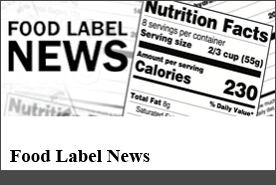
July 2017 - Volume 17, Number 7
Greetings!
We've been busy behind the scenes to make our Food Consulting Company website even more user-friendly and informative for you. We've added access to more of the information you need to find easily. Check out your favorite sections which you may want to bookmark for future reference: Quick References, Reader Q+A, past newsletter issues. Please let us know what you find most useful so that we can bring you more of that in the future.
In this issue:
- Spice and Color in Ingredient Labeling
- What's News in the Food Label Community
- Reader Q+A: Warning Statements for Sugar Alcohols
- Reader Favorites: Ground 2 Table Adds More Spice – A Case Study
Happy perusing!
![]()
Karen C. Duester, President, Food Consulting Company

Spice and Color in Ingredient Labeling
Last month's article covered the tricky aspects of FDA's flavor labeling rules, and this month we tackle the issue of labeling spices and colors which also has its share of nuances.
Beginning with spices, not all ingredients consumers may consider to be "spices" are categorized as such by FDA. FDA defines "spices" as aromatic vegetable substances that function as seasonings rather than as sources of nutrition. For example: basil, oregano, parsley and sage provide flavors yet insignificant nutritional value. These ingredients may be combined and listed as a single ingredient "spices" in the ingredient statement or they may be called out separately.
Vegetables that are traditionally regarded as foods are not considered to be spices. For example: onions, garlic and celery cannot be combined and listed as the single ingredient "spices" in the ingredient statement, even when they are in powder form. Each of the ingredients must be listed individually.
For colors, any added ingredient that functions as a color in food must be specified according to FDA's color additive regulations. There are two classes of food colors; one requires batch certification and one does not. Each class has its own regulations with regard to ingredient labeling.
- Certifiable color additives are typically synthetic and require FDA certification testing on every batch to validate purity and safety. These colors must be listed in the ingredient statement by common or usual name. Examples of certifiable colors include: Yellow 6, Red 40 and Blue 2 Lake.
- Exempt color additives do not require FDA batch certification testing and most may be listed in the ingredient statement in the following ways: "colored with (common name)," "color added" or "artificial color," among others. Examples of exempt colors include: beet juice color, vegetable or fruit juice color and caramel color.
- FDA considers all colors added to be artificial colors and does not permit use of the term "natural colors." Therefore, if a food contains an ingredient that functions as a color, the label claim "no artificial colors" is not allowed.
Finally, what about ingredients that function as both a seasoning and a color? There are several spices like paprika, turmeric and saffron that can have dual functions. When these ingredients are used as spices, they must be listed in the ingredient statement by the term "spice and coloring" or by their common name, such as "paprika." However, if a spice ingredient is used as a color additive only, using the common name in the ingredient statement is not sufficient; rather it must follow the ingredient labeling rules for exempt color additives above. That is, paprika would be listed as "paprika color" or "color added."
Bullseye: There is a distinction between FDA and USDA regulations. USDA allows spices and certain ingredients (as long as they are not colors) to be combined in an ingredient statement and called "natural flavors" (or "natural flavorings") or simply "flavors" (or "flavorings"). Therefore, spices, spice extractives, essential oils, oleoresins, onion powder, garlic powder and celery powder are considered natural flavors according to USDA regulations, whereas only spice extractives, essential oils and oleoresins are considered "natural flavors" per FDA regulations.

What's News in the Food Label Community
- FDA extends compliance date new Nutrition Facts label (17+ likes)
- Drink mixer RACC (11+ comments)
- Sulfite warning statement (11+ comments)
- Artificial colors declaration (9+ comments)
- Juice concentrate ingredient labeling (7+ comments)

Answers to Your Important Questions
Q. If sugar alcohols are used in a food or supplement, must the label include a warning statement?
— G.D., Food Scientist, Colorado
A. FDA requires that food and supplement labels include a warning statement when either sorbitol and/or mannitol are used at certain levels in a formula. The issue is that these ingredients are only partially digested in the intestines and may produce intestinal discomfort in some people. The warning: "Excess consumption may have a laxative effect" is required. MORE

In Case You Missed It...
Ground 2 Table Adds More Spice – A Case Study

What Matters Most in Food Labeling
Food Label News, now in its 17th year, is a monthly e-newsletter reaching over 10,000 subscribers around the world. We welcome your colleagues to subscribe for news and insights about food labels.

Your Virtual Food Label Partner
Food Consulting Company, founded in 1993, provides nutrition analysis, food labeling and regulatory support for more than 1,500 clients worldwide. Our guarantee: 100% regulatory compliance. Contact us for the help you need now.
You may reprint all or part of this newsletter provided you attribute it to Food Label News and include a link to www.foodlabels.com.
Copyright © 2000-2017. Food Consulting Company, Del Mar, CA. All rights reserved. | CONFIDENTIALITY + PRIVACY